 By Pepper Parr
By Pepper Parr
January 10th, 2017
BURLINGTON, ON
Something just didn’t’ seem right about this one. Perhaps it is because we don’t understand the world of artists but asking a sculptor to send in an Expression of Interest for a possible $140,000 commission within 10 days suggests that the decision has already been made and the request for those Expressions is released to cover the tracks.
The location for this piece of sculpture is nice – part of the RBG Rock Garden.
We pass this on – and wonder if we are misleading the sculptors in the community
Here are the details. We will watch with interest and see who is awarded the commission.
ROYAL BOTANICAL GARDENS | REQUEST FOR EXPRESSIONS OF INTEREST
Deadline: Friday, January 20, 2017
Budget: $140,000 CAD (maximum)
The Royal Botanical Gardens invites artists to submit Expressions of Interest to create a permanent Thomas McQuesten commemorative artwork to be installed in the Dalglish Family Courtyard at the Royal Botanical Gardens. This competition is open to professional Canadian artists or artist-led teams.
The call:
Artist Opportunity
The Royal Botanical Gardens invites artists to submit Expressions of Interest to create a permanent Thomas McQuesten commemorative artwork to be installed in the Dalglish Family Courtyard at the Royal Botanical Gardens. This competition is open to professional Canadian artists or artist-led teams*.
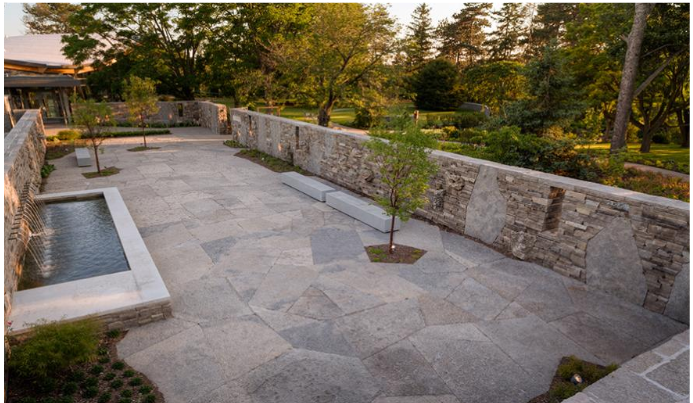
Dalglish Family Courtyard at the Royal Botanical Gardens.
An artwork proposal is not requested at this time. This is a two-phase process: in Phase One, applicants will be reviewed on the basis of artistic merit of past work, professional qualifications and experience. In Phase Two, short-listed artists will be required to submit an artwork concept proposal and maquette. Artists selected for the short-list will be provided with a full Request for Proposals outlining detailed artwork specifications prior to developing their proposals. Short-listed artists will be paid an artist fee of $1500 to develop their proposals.
* A professional artist is an individual who has specialized skills and/or training in his/her artistic discipline (not necessarily in academic institutions), has a history of public presentation and is critically recognized as an artist.
Artwork Goals
This commission will commemorate Thomas Baker McQuesten, one of our nation’s tireless advocates for conservation and founder of the Royal Botanical Gardens. Set in the Dalglish Family Courtyard, this sculpture will stand as a proud reminder of McQuesten’s legacy and the RBG’s long-standing commitment to the stewardship of our land.
The goals of this project include:
• Celebrate an iconic figure in Canadian history in connection with Canada’s 150th Anniversary of Confederation
• Enhance the Dalglish Family Courtyard with an inspiring public artwork
• Provide a space for contemplation and commemoration
• Tell the story of McQuesten and his contribution to local and national infrastructure, conservation and beautification
Background
The Royal Botanical Gardens
For over 80 years Royal Botanical Gardens (RBG) has been an ecological jewel at the western tip of Lake Ontario. Conceived and founded through the tireless efforts of early conservationist Thomas Baker McQuesten, RBG lands were set aside to create the region’s first botanical garden. Patterned after Kew Gardens in England, RBG was created to serve as both a regional botanical tourism site and an environmental agency. In his book “Garden with a View”, former Executive Director Dr. Leslie Laking explains RBG’s unique role in society:
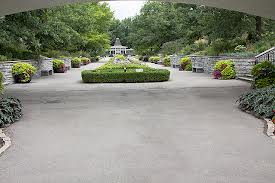
Hendrie Gardens RBG
“Royal Botanical Gardens puts nature’s beauty on display, but it isn’t a park system. It teaches but it isn’t a school. It protects and preserves forest and marsh, but it isn’t a conservation authority. It collects and propagates botanical knowledge and plant life, but it is not a library, museum, or laboratory. It is all those things and more than their sum”.
Designated as a national historical site, RBG is revered worldwide for its extensive 400 acres of display gardens. What makes RBG unique is that it also protects and stewards over 2300 acres of environmentally sensitive lands and diverse ecosystems that connect the Niagara escarpment to Lake Ontario. In acknowledgement of this crucial environmental role, Royal Botanical Gardens was granted a provincial mandate in 1941 for the development of four areas of focus: Conservation, Education, Horticulture and Science. In the 70 years that followed, RBG has established a national and international reputation as a living laboratory for science, a connecting point for children in their early embrace of nature, a leader in sustainable gardening and the standard-bearer for ecological restoration and plant preservation.
In the face of devastating environmental threats worldwide, RBG is more relevant now than ever before. Its established and evolving environmental programs provide straightforward, workable solutions designed to maintain sustainable biodiversity in Canada, for the world.
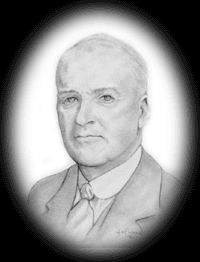
Thomas Baker McQuesten
Thomas McQuesten
Thomas Baker McQuesten (June 30, 1882 – January 13, 1948) was born in Hespeler, Ontario (now Cambridge) and received his primary and secondary school education in Hamilton. Following high school, McQuesten attended the University of Toronto and continued his studies at Osgoode Hall, receiving his law degree in 1907. McQuesten served as an alderman on Hamilton City Council and later, a Liberal member of the Legislative Assembly of Ontario (representing Hamilton- Wentworth).
McQuesten, whose family had deep roots in Hamilton was a key player in infrastructure development across Ontario and is credited with bringing forward the Queen Elizabeth Way, Royal Botanical Gardens and many other projects. McQuesten was a tireless advocate for the development of parks and conservation areas. For instance, his advocacy for parks on Hamilton, Ontario City Council earned him an appointment to the permanent position on the Board of Park Management in 1922, where he remained until his death in 1948. In this position, he supported the construction of the Rock Garden and other landscaped areas on the Burlington Heights (Ontario), which became part of Royal Botanical Gardens in 1932. After his retirement from electoral politics, McQuesten resumed his interest in RBG and became an executive member of that organization, active there until just before he died.
Artwork Location
The artwork will be located in the Dalglish Family Courtyard. The courtyard serves as the entry point to the newly rejuvenated Rock Gardens at the Royal Botanical Gardens. The three-year, $20 million project provided the garden with major upgrades in infrastructure, accessibility and landscape design. This included improvements to the garden’s structural integrity, water and sewage systems, visitor accessibility, and architectural landscape. In addition, a new visitor centre was constructed to serve as a year round destination for business and private functions.
Just outside the visitor centre, the Dalglish Family Courtyard is an elegant space that serves as both a welcoming point for guests making their way outdoors and a venue for social occasions and gatherings. Alpine plants representing true rock garden vegetation grow from the beautiful stone walls, and gentle waterfalls creates a peaceful atmosphere.
The artwork will be sited in the eastern portion of the courtyard is the primary location for the artwork. Artists may propose an artwork in series or ancillary piece that makes use of Site B as a secondary location (optional).
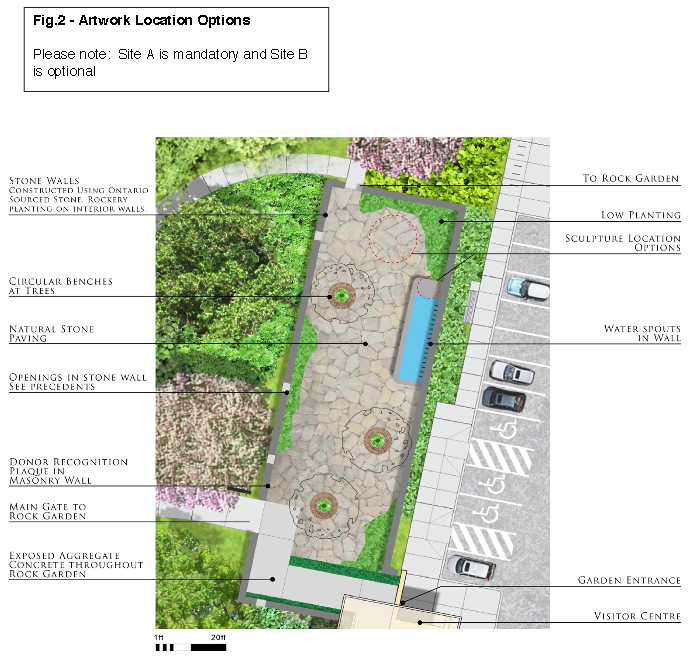
Locations for the sculpture in the Daiglish Family Courtyard.
Artwork Design Parameters
The artwork must adhere to the following design parameters:
• The artwork must be an exterior, sculptural installation.
• The artwork should contain elements that are representative of Thomas Baker McQuesten. The artwork could be a formal commemorative sculpture or could contain elements that are more interpretive in nature in combination with figurative elements
• The artwork should express the passion and commitment of McQuesten to the natural environment and the Royal Botanical Gardens
• Fabricated using high quality, long-lasting materials that are highly resistant to theft, vandalism and weathering
• Must not pose a risk to public safety (i.e. no sharp points, does not allow climbing to restricted areas, no slip hazards, etc.)
• Does not incorporate light, video or sound elements
• Artwork does not restrict visitor’s movement within the courtyard or compromise accessibility standards
• Meets all Ontario building code standards (https://www.mah.gov.on.ca/Page7393.aspx);
• The selected artist will be required to submit drawings certified by a structural engineer licensed to operate in Ontario
Budget
The budget for this project is $140,000 CAD (maximum, exclusive of HST). This is the total amount available for all related expenses of this public art project including (but not limited to): artist fees, materials, site preparation, technical consultation, fabrication, installation, any required above or below-grade foundations, insurance, equipment, permit fees, and travel.
RBG grounds staff will be available to assist in site preparations, general labour and have a significant skillset and available equipment that may be used during installation. To ensure the budget is being maximized an installation consultation will occur with each short-listed artist.
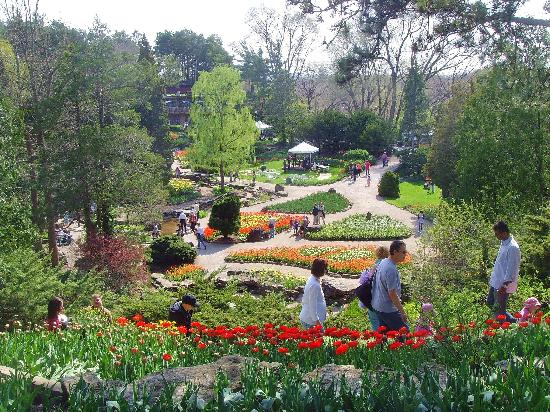
When the flowers and plants are in bloom the RBG is one of the most beautiful places on the planet.
Eligibility
This competition is open to all professional Canadian artists. Artist collectives and/or artist-led teams are also encouraged to apply. The selected artist must be able to travel to Burlington, Ont. for a minimum of two visits: one technical consultation meeting and one visit to manage the installation of the artwork and to engage in public dialogue (i.e. artist talk / public unveiling event).
The selection panel is comprised of the following representatives:
- Camilla Dalglish, major gift donor
- John Best, author, Thomas Baker McQuesten: Public Works, Politics, and Imagination
- Tobi Bruce, Director, Collection & Exhibitions / Senior Curator, Art Gallery of Hamilton
- Jeremy Freiburger, Executive Director, Cobalt Connects
- Andrew Hunter, Fredrik S. Eaton Curator, Canadian Art, Art Gallery of Ontario
- Mark Runciman, CEO, Royal Botanical Gardens
- Maryella Leggat, resident & RBG supporter.
Estimated Project Timeline (2016-17)
December 2016 Expression of Interest document released
January 20, 2017 Deadline for Stage One: Expression of Interest
By January 31, 2017 Selection committee applications, selects short-listed artists
March 17, 2017 Short listed artists’ Concept Proposals due
By March 31, 2017 Steering committee reviews proposals and selects winning artist Selected artist enters into a contract with the Royal Botanical Gardens
September / October 2017 Artwork is installed
What’s the rush? If they are going to commemorate McQuesten -do it right.


















“Perhaps it is because we don’t understand the world of artists but asking a sculptor to send in an Expression of Interest for a possible $140,000 commission within 10 days suggests that the decision has already been made and the request for those Expressions is released to cover the tracks.”
It is fairly standard for larger ($100, 000?) projects to request an “Expression of Interest” to become part of the initial Call. The short listed artists from this will often be paid a fee to create a maquette (model) and the final decision is made from the maquette
Professional Visual Artist is defined by CARFAC (Canadian Artists Representatives) and their definition is based on international standards.
A professional visual artist:
1/ is a graduate of a university offering a visual arts education or equivalent
2/ makes a living or is paid artist fees on a regular practice
3/ exhibits on a regular basis
4/ is recognized as a professional by their peers
More unnecessary spending at a time when municipal taxes continually increase over 4% each year. Such a waste, and for an art project that only those that pay to enter the RBG will ever see. How about just keeping that money in the bank and saving it for once? In case you haven’t noticed, Burlington is a little cash-strapped at the moment. I wish City Hall would first ask themselves, is this art project a “want” or a “need”? How about prioritizing spending and NOT finding new ways to waste our money!
Editor’s note: The funds were privately donated.
Love how they define Professional artist several times . So by me submitting a proposal to place a couple of rocks on top of each other and calling “it” art would not qualify Are any of the judging panel “professional artists” and what qualifications do they have to judge entries You would think after the orchid disaster art installation on Upper middle road ,people would stop this nonsense especially the dollar figure attached to this tender .